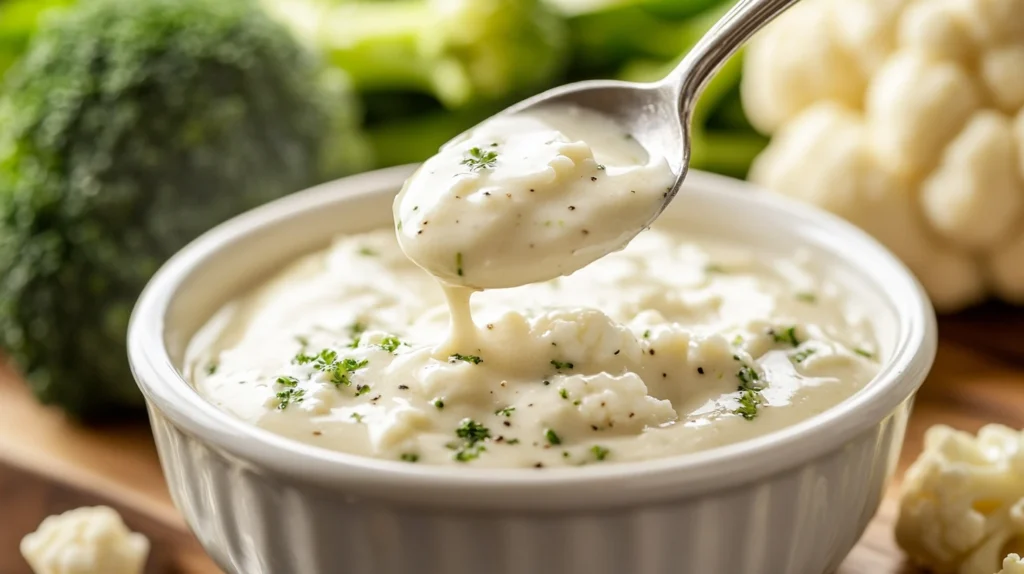Salads are the ultimate combination of nutrition and flavor, and when it comes to versatility, the broccoli cauliflower salad reigns supreme. Packed with crunch, vibrant colors, and a medley of fresh vegetables, this dish offers a healthy and satisfying option for any meal. Whether you’re preparing it as a side dish for a family barbecue or a quick, nutritious lunch, broccoli cauliflower salad brings convenience and nourishment to the table.
The real beauty of this salad lies in its adaptability. With broccoli and cauliflower as the core ingredients, you can mix and match dressings, add protein, or even make it vegan. Plus, the high fiber content and rich array of vitamins and minerals make it a powerhouse for boosting energy and improving overall health.
In this article, we’ll dive into the nutritional benefits of broccoli and cauliflower, guide you through step-by-step preparation, explore exciting recipe variations, and share tips on serving this delightful salad. Whether you’re a health enthusiast or just looking for a new dish to try, this article will equip you with everything you need to know about broccoli cauliflower salad.

Why Choose Broccoli and Cauliflower for Your Salad?
Broccoli and cauliflower are often celebrated as nutritional powerhouses, and for good reason. Their unique combination of health benefits, taste, and versatility make them ideal for salads. Here’s a closer look at why these vegetables deserve a central place in your diet.
Nutritional Benefits of Broccoli Cauliflower Salad
Broccoli and cauliflower are members of the cruciferous vegetable family, known for their high levels of antioxidants and disease-fighting properties. Here’s why they stand out:
- Rich in Antioxidants: Both broccoli and cauliflower contain powerful antioxidants like sulforaphane, which help reduce inflammation and combat oxidative stress in the body.
- High Fiber Content: A single serving of these vegetables provides a significant portion of your daily fiber needs, promoting gut health and aiding digestion.
- Vitamin Powerhouse: Broccoli is particularly high in vitamin C, which supports the immune system, while cauliflower provides a good dose of vitamin K, essential for bone health.
- Low in Calories, High in Volume: Perfect for weight management, these vegetables are low in calories yet provide a satisfying crunch and volume to meals, keeping you fuller longer.
Low-Calorie and High-Fiber Broccoli Cauliflower Salad Advantages
For those looking to manage their weight or improve digestion, broccoli and cauliflower are fantastic choices. Each cup contains approximately:
- Broccoli: 55 calories, 5 grams of fiber.
- Cauliflower: 25 calories, 3 grams of fiber.
This means you can enjoy a generous portion of the salad without feeling guilty. Additionally, the high fiber content helps regulate blood sugar levels, reducing the risk of diabetes and other metabolic conditions.
Essential Vitamins in Broccoli and Cauliflower Salad
Including broccoli and cauliflower in your diet also ensures that you’re getting an array of essential nutrients, such as:
- Vitamin C: Boosts immunity and promotes healthy skin.
- Vitamin K: Plays a crucial role in blood clotting and bone metabolism.
- Folate: Important for DNA synthesis and repair, especially crucial for pregnant women.
- Potassium: Helps maintain fluid balance and supports heart health.
Why They’re Perfect for Salads
Broccoli and cauliflower are ideal for salads because of their firm texture and neutral flavor. They hold their shape well when mixed with dressings and other ingredients, unlike more delicate greens that may wilt. Additionally, their slightly nutty and earthy flavor profiles pair wonderfully with tangy dressings, creamy sauces, or even a simple olive oil and lemon drizzle.
By choosing broccoli and cauliflower as the foundation of your salad, you’re ensuring a meal that is as nourishing as it is delicious.
Ingredients for Broccoli Cauliflower Salad
A great broccoli cauliflower salad starts with fresh, high-quality ingredients that combine for a burst of flavor and texture. Whether you’re aiming for a classic preparation or a creative twist, the ingredients you choose can make all the difference.
Fresh Vegetables
The stars of this salad are, of course, broccoli and cauliflower. Here’s how to prepare them:
- Broccoli: Choose vibrant green florets with firm stems. Wash thoroughly and chop into bite-sized pieces.
- Cauliflower: Look for creamy white heads with tightly packed florets. Trim and cut into small pieces for even distribution in the salad.
Beyond the main ingredients, consider adding these complementary vegetables:
- Red Onion: Adds a sharp, tangy bite that contrasts well with the creaminess of dressings.
- Carrots: Shredded carrots contribute a touch of sweetness and color.
- Bell Peppers: Chopped red or yellow bell peppers provide a pop of color and a juicy crunch.
Dressings and Seasonings
The dressing is the heart of the salad, tying all the ingredients together. Depending on your preferences, you can opt for creamy, tangy, or zesty dressings:
- Classic Creamy Dressing: A blend of mayonnaise, Greek yogurt, apple cider vinegar, and a touch of honey works beautifully.
- Tangy Vinaigrette: Olive oil, lemon juice, Dijon mustard, and a hint of garlic create a light and flavorful dressing.
- Herb Infusion: Add fresh or dried herbs like dill, parsley, or chives for an aromatic twist.
Seasonings like salt, pepper, and a pinch of sugar (optional) enhance the overall taste without overpowering the fresh flavors of the vegetables.
Optional Add-ins: Nuts, Seeds, and Fruits
To elevate the texture and flavor, consider these optional add-ins:
- Nuts: Sliced almonds, walnuts, or pecans bring a satisfying crunch and nutty richness.
- Seeds: Sunflower or pumpkin seeds add a subtle earthy flavor and a nutrient boost.
- Dried Fruits: Raisins, cranberries, or diced apricots introduce a sweet and chewy element.
- Cheese: Crumbled feta, shredded cheddar, or Parmesan adds a creamy or sharp flavor profile.
Customizing to Taste Preferences
The beauty of broccoli cauliflower salad is its versatility. You can adjust the ingredients to suit dietary preferences or experiment with flavors for different occasions. For example:
- For a keto-friendly version, omit sugary dressings and focus on high-fat add-ins like avocado or bacon bits.
- For a vegan option, use plant-based mayonnaise or tahini for the dressing.
With the right balance of vegetables, dressings, and add-ins, you’re set to create a vibrant salad that’s as visually appealing as it is delicious.
How to Prepare Broccoli Cauliflower Salad
Making a broccoli cauliflower salad is simple and rewarding, requiring minimal effort to achieve maximum flavor and nutrition. Follow these steps to create a delicious salad that’s ready to impress.
Step-by-Step Preparation Process
- Gather Ingredients
Ensure all ingredients are fresh and prepped. Wash the broccoli and cauliflower thoroughly under running water to remove any dirt or debris. - Chop the Vegetables
- For broccoli, remove the tough stems and cut the florets into small, bite-sized pieces.
- For cauliflower, trim away the green leaves and core, then chop the florets into similarly sized pieces.
Keeping the florets uniform ensures even mixing and consistent texture.
- Optional Blanching
While broccoli and cauliflower can be used raw, blanching softens them slightly and enhances their vibrant colors:- Bring a pot of water to a boil and prepare a bowl of ice water.
- Add the florets to the boiling water for 1-2 minutes, then transfer them immediately to the ice water to stop cooking. Drain thoroughly.
- Prepare Additional Ingredients
- Dice red onion, shred carrots, and chop bell peppers (if using).
- Toast nuts or seeds lightly in a dry skillet to bring out their natural flavors.
- Mix the Dressing
Whisk together your chosen dressing ingredients. For a creamy option, mix mayonnaise, Greek yogurt, apple cider vinegar, honey, salt, and pepper. Adjust seasoning to taste. - Combine Ingredients
In a large mixing bowl, combine the chopped broccoli, cauliflower, and additional vegetables. Pour the dressing over the mixture and toss until evenly coated. - Chill the Salad
Cover the bowl and refrigerate the salad for at least 30 minutes. Chilling allows the flavors to meld, making the salad even more delicious.
Tips for Perfectly Chopped Broccoli and Cauliflower
- Use a sharp knife to avoid crushing the florets while cutting.
- If you’re short on time, consider using pre-cut broccoli and cauliflower, available in many grocery stores.
Blanching vs. Raw: Which Is Better?
- Raw Broccoli and Cauliflower: Retain their maximum crunch and a slightly earthy flavor, ideal for a fresh, crisp salad.
- Blanched Broccoli and Cauliflower: Offer a softer texture and a milder taste, which some people find more palatable. Blanching also makes the salad more visually appealing as it enhances the bright green and creamy white hues.
Avoiding Common Mistakes
- Overdressing the Salad: Add the dressing gradually to avoid overwhelming the vegetables.
- Skipping the Chill Step: Letting the salad sit in the fridge allows the flavors to blend harmoniously.
- Uneven Florets: Ensuring the broccoli and cauliflower pieces are uniform in size helps the salad look and taste better.
With these steps and tips, your broccoli cauliflower salad will be a hit at any gathering or as a healthy addition to your weekly meals.
Variations of Broccoli Cauliflower Salad
One of the best things about broccoli cauliflower salad is its adaptability. Whether you’re following a specific diet or simply experimenting with new flavors, there are countless ways to tailor this dish to suit your preferences.
Keto-Friendly Recipe Variations
For those on a ketogenic diet, broccoli cauliflower salad can easily be made low-carb and high-fat. Here’s how:
- Dressing: Use a rich, creamy dressing made from full-fat mayonnaise, sour cream, and a splash of lemon juice. Avoid any sweeteners unless keto-approved options like erythritol or stevia are used.
- Add-ins: Crumbled bacon, shredded cheddar cheese, and diced avocado add healthy fats while keeping carbs low.
- Avoid: Skip ingredients like dried fruits or sugary dressings, as these can increase the carb content.
This keto version pairs perfectly with grilled meats or can be enjoyed as a satisfying meal on its own.
Vegan and Vegetarian Options
For a plant-based twist, you can make a broccoli cauliflower salad that’s entirely vegan or vegetarian.
- Dressing Alternatives: Swap mayonnaise or yogurt with plant-based options like cashew cream, tahini, or vegan mayonnaise. A light vinaigrette made with olive oil, lemon juice, and Dijon mustard is also a great option.
- Add-ins: Incorporate chickpeas, roasted nuts, or cubed tofu for added protein. Fresh herbs like parsley and cilantro elevate the flavor while keeping it light and fresh.
- Cheese Substitutes: If you enjoy a cheesy flavor, sprinkle nutritional yeast for a dairy-free alternative.
This version caters to a wide range of dietary needs and can easily become a staple in plant-based kitchens.
Adding Protein: Chicken, Tofu, and More
Turning broccoli cauliflower salad into a protein-packed meal is simple. Here are some protein-rich additions to try:
- Grilled Chicken: Chop leftover grilled chicken breast into bite-sized pieces and mix it into the salad for a hearty, balanced dish.
- Hard-Boiled Eggs: Add slices or quarters of hard-boiled eggs for a creamy texture and a boost of protein.
- Tofu or Tempeh: For a vegetarian-friendly protein option, marinate and pan-fry tofu or tempeh before mixing it in.
- Shrimp: Lightly seasoned and sautéed shrimp can add a seafood twist to the salad.
Adding protein transforms this salad from a side dish into a filling main course that works for lunch or dinner.
Unique Flavor Twists
- Mediterranean Style: Add chopped cucumbers, cherry tomatoes, Kalamata olives, and a sprinkle of feta cheese. Drizzle with a lemon-oregano vinaigrette for a Mediterranean flair.
- Asian-Inspired: Use a sesame-ginger dressing and include toasted sesame seeds, julienned carrots, and edamame for a flavorful twist.
- Sweet and Savory: Combine dried cranberries, diced apples, and roasted pecans for a delightful mix of sweet and savory flavors.
Seasonal and Festive Variations
This salad can also be customized for holidays or seasonal ingredients.
- Summer: Add fresh berries like strawberries or blueberries, along with a citrus vinaigrette.
- Fall and Winter: Incorporate roasted sweet potatoes, pomegranate seeds, or candied nuts for a hearty, seasonal dish.
These variations showcase the versatility of broccoli cauliflower salad, ensuring it never gets boring no matter how often you make it.
Serving Ideas for Broccoli Cauliflower Salad
Broccoli cauliflower salad is a versatile dish that can shine on its own or complement a variety of meals. Knowing how to serve and pair it with other dishes can elevate your dining experience.

Best Occasions to Serve the Salad
This salad is perfect for numerous occasions, whether casual or formal:
- Family Dinners: A healthy side dish that pairs well with everyday meals.
- Barbecues and Picnics: Its hearty texture and robust flavors hold up well outdoors, making it ideal for potlucks and picnics.
- Holidays and Celebrations: With a few festive add-ins, it can become a show-stopping side dish for Thanksgiving, Christmas, or New Year’s gatherings.
- Meal Prepping: As it stores well in the refrigerator, broccoli cauliflower salad is excellent for meal prepping for lunches or quick dinners.
Pairing with Other Dishes
The flavors and textures of broccoli cauliflower salad make it a great companion to a variety of main courses.
- The salad’s crunchy and creamy elements balance the smoky, savory flavors of grilled meats.
- Seafood: Pair it with salmon, shrimp, or grilled white fish for a light yet filling meal.
- Soups and Breads: Complement hearty soups like tomato bisque or chicken noodle soup with a bowl of this salad. It also pairs well with freshly baked bread or breadsticks.
- Vegetarian Dishes: Enjoy it with stuffed bell peppers, vegetable casseroles, or a hearty grain dish like quinoa or wild rice.
Presentation Tips
- Serve Chilled: Always serve the salad chilled for the best flavor and texture.
- Use a Vibrant Platter: The colorful mix of broccoli, cauliflower, and add-ins looks stunning on a white or brightly colored serving dish.
- Garnish with Fresh Herbs: A sprinkle of fresh parsley, chives, or dill can enhance both the presentation and the flavor.
Portioning and Storage Tips
- Portioning: For a side dish, estimate about 1 cup per person. If serving as a main course, 2 cups per person is ideal.
- Storage:
- Store leftovers in an airtight container in the refrigerator for up to 3-4 days.
- Avoid freezing the salad, as the texture of the vegetables and dressing may degrade when thawed.
Quick Serving Tricks for Busy Days
If you’re in a rush, here are some time-saving tips:
- Pre-Cut Vegetables: Use pre-washed and chopped broccoli and cauliflower from the store.
- Make Ahead Dressing: Prepare the dressing in advance and store it separately. Toss it with the vegetables just before serving.
- Double the Recipe: Make a large batch to enjoy throughout the week. The flavors intensify over time, making the salad even more delicious on the second or third day.
With these serving ideas and pairing suggestions, broccoli cauliflower salad becomes a versatile dish that fits seamlessly into any menu.
While reading about broccoli cauliflower salad, you might also enjoy these recipes from our collection:
- Explore how to elevate your salad game with a Burrata Salad – fresh and creamy recipes perfect for every season.
- Learn about making a delicious and balanced Chicken Caesar Salad, ideal for any meal.
- If you’re looking for another creamy side, don’t miss the Hawaiian Macaroni Salad.

Frequently Asked Questions
Can you eat broccoli and cauliflower cold?
Yes, broccoli and cauliflower can be eaten cold, and they are often enjoyed this way in salads and snack trays. When served raw or blanched, their natural crunch and flavor shine. Eating them cold retains the maximum amount of nutrients, particularly water-soluble vitamins like vitamin C, which can be reduced during cooking. Pair cold broccoli and cauliflower with dips or dressings for a satisfying, healthy snack.
Is it OK to eat broccoli and cauliflower every day?
Absolutely, eating broccoli and cauliflower daily can be highly beneficial, as both are packed with nutrients like fiber, vitamins C and K, and antioxidants. Regular consumption supports digestion, boosts immunity, and reduces inflammation. However, moderation is key, as excessive consumption of cruciferous vegetables can lead to bloating or interfere with thyroid function in people with thyroid issues. A balanced diet that includes a variety of vegetables is the best approach.
How cold is too cold for cauliflower?
Cauliflower is fairly cold-tolerant, but prolonged exposure to temperatures below 25°F (-3.8°C) can damage the plant. While it can withstand light frost, extreme cold can stunt growth or cause discoloration in the heads. If you’re growing cauliflower, using row covers or bringing potted plants indoors during freezing temperatures can help protect them.
What is the most cold-tolerant vegetable?
Kale is one of the most cold-tolerant vegetables, able to survive temperatures as low as 10°F (-12°C) and sometimes even lower with adequate protection. Other cold-hardy vegetables include spinach, collard greens, Brussels sprouts, and Swiss chard. These crops thrive in cool weather and can often withstand frost, making them excellent choices for winter gardening.
Conclusion
Broccoli cauliflower salad is a versatile, nutritious, and delicious dish that can easily become a staple in your meal rotation. Whether you’re preparing it for a family dinner, a festive occasion, or as part of your weekly meal prep, this salad offers something for everyone. Its rich combination of crunch, flavor, and health benefits makes it a standout choice for those seeking a balanced diet without sacrificing taste.
From its nutrient-packed base of broccoli and cauliflower to its customizable dressing and add-ins, this salad can be tailored to suit a variety of preferences and dietary needs. Whether you’re going keto, vegan, or simply looking for a new way to enjoy fresh vegetables, broccoli cauliflower salad has you covered.
Now that you’re equipped with a step-by-step guide, creative variations, serving ideas, and answers to common questions, it’s time to put your knowledge to use and create your own version of this classic dish. Dive into your kitchen, experiment with ingredients, and enjoy the wholesome goodness of broccoli cauliflower salad. Your taste buds—and your health—will thank you!

Broccoli Cauliflower Salad – A Crunchy, Creamy, and Easy Side Dish
Equipment
- ✔ Large mixing bowl
- ✔ Cutting board
- ✔️ Sharp knife
- ✔ Measuring cups and spoons
- ✔️ Whisk (for the dressing)
- ✔️ Serving spoon
Ingredients
- For the Salad:
- ✔️ 3 cups fresh broccoli florets chopped into bite-sized pieces
- ✔️ 3 cups fresh cauliflower florets chopped into bite-sized pieces
- ✔️ 6 slices crispy bacon cooked and crumbled
- ✔️ ½ cup shredded cheddar cheese
- ✔️ ¼ cup chopped red onion
- ✔️ ¼ cup sunflower seeds or chopped almonds for extra crunch
- For the Dressing:
- ✔️ ¾ cup mayonnaise or Greek yogurt for a lighter option
- ✔️ 2 tablespoons apple cider vinegar or white vinegar
- ✔️ 1 tablespoon honey or maple syrup
- ✔️ ½ teaspoon salt
- ✔️ ¼ teaspoon black pepper
Instructions
- Step 1: Prepare the Ingredients
- 1️⃣ Chop the broccoli and cauliflower into small, bite-sized florets.
- 2️⃣ Dice the red onion and cook the bacon until crispy, then crumble it into small pieces.
- 3️⃣ Shred the cheddar cheese and set all ingredients aside.
- Step 2: Make the Dressing
- 1️⃣ In a small bowl, whisk together mayonnaise, apple cider vinegar, honey, salt, and black pepper until smooth.
- 2️⃣ Taste and adjust seasoning as needed.
- Step 3: Assemble the Salad
- 1️⃣ In a large mixing bowl, combine broccoli, cauliflower, bacon, shredded cheese, red onion, and sunflower seeds.
- 2️⃣ Pour the dressing over the salad and toss until everything is evenly coated.
- Step 4: Chill and Serve
- 1️⃣ Cover the salad and refrigerate for 30 minutes to allow flavors to meld.
- 2️⃣ Serve chilled and enjoy!
Notes
✔️ Add more crunch – Try adding chopped almonds, pecans, or pumpkin seeds.
✔️ Make it ahead – This salad stores well for up to 3 days in the fridge.
✔️ For a sweeter twist – Add ½ cup of dried cranberries.

